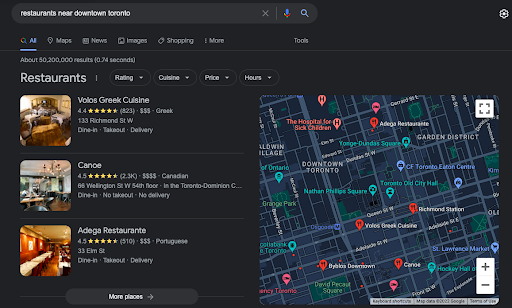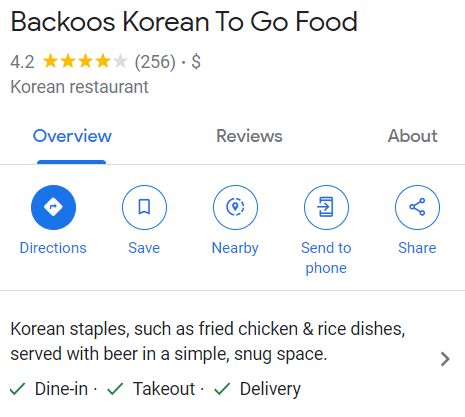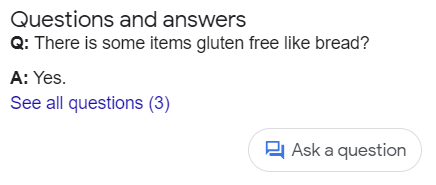10 tactics to take your local search strategy to the next level
A robust local search strategy is the cornerstone of success for small businesses trying to make a name for themselves in their community. That’s why we have gathered 10 effective ways you can improve their local search strategy. If you’re ready to enhance your SMBs’ online visibility and connect them with their target audience in a way that truly resonates, this is the blog for you.
Become a trusted expert to your clients in the field of local SEO. Download “How to conquer local search engine optimization (SEO): The comprehensive guide” right now.
Here’s how to dominate local SEO, unlock the full potential of your small business clients' local presence, and establish a stronger, more competitive edge over the competition.
Table of Contents
- Optimize Google Business Profile
- Perform local keyword research
- Manage and optimize local citations and directories
- Respond to online reviews and ratings
- Create localized content
- Optimize your client’s website for mobile
- Implement local link building
- Create location-specific landing pages
- Encourage social media engagement
- Perform local SEO audits
- Step 1: Gather business information
- Step 2: Google Business Profile analysis
- Step 3: Local citations audit
- Step 4: Online reviews evaluation
- Step 5: Website optimization review
- Step 6: Local content analysis
- Step 7: Mobile-friendliness check
- Step 8: Local backlink assessment
- Step 9: Competitor analysis
- Step 10: Local SEO recommendations
1. Optimize Google Business Profile
An optimized Google Business Profile (GBP) not only helps small businesses stand out in the local search ecosystem but also improves their chances of appearing in Google's Local 3-Pack results.
What is a Google Local 3-Pack?
When someone searches for a specific product or service on Google, the first thing to show up is the Google Local 3-Pack, which consists of the top three Google Maps results that appear most relevant to the searcher’s query. Check out our article “Google local listings information” to learn more about how Google local listings info is collected and sourced.
(Source: Vendasta)
Here are some effective tips and tactics to optimize your client’s Google Business Profile:
Complete and accurate information
When reviewing the client’s business listing, it’s important to ensure that all NAP information is accurate, including the business’s full name, address, phone number, website, and their hours of operation.
Choose the right category
Select the category that best represents the client's business to enhance the profile's visibility in relevant searches.
Engaging business description
Craft a compelling and concise business description that highlights relevant keywords and the client’s unique selling points. Check out this example from a popular cafe:
(Source: Screenshot from Google)
High-quality photos and video
Upload appealing images and videos that showcase the business, products, services, and overall ambiance to make the profile visually more engaging, like this example below:
(Source: Screenshot from Google)
Monitor and respond to reviews
Regularly monitor and respond to customer reviews on GBP, both positive and negative, showing appreciation for positive feedback and addressing concerns professionally and promptly.
Also see: Google review management: 5 ways to succeed in online reputation
Post regularly
Utilize the Google Posts feature to share updates, promotions, events, and other relevant content to keep the audience informed and engaged. It’s important to note certain types of content can be rejected by Google, so keep the content business-related, and avoid including phone numbers within the copy.
Pro-tip: Post often to keep your presence on the listing current. Posts get archived by Google after only 6 months.
Use attributes
Take advantage of attributes like "women-led," "outdoor seating," or "free Wi-Fi" to provide more context about the business to potential customers. If your client owns a restaurant, for instance, highlighting their delivery service can significantly influence customers to choose their establishment over others that don't advertise this convenience.
(Source: Screenshot from Google)
Enable messaging
Enable the messaging feature to allow local SEO leads to connect with the business directly for inquiries or bookings.
Utilize Q&A
Monitor and respond to user-generated questions to provide helpful information and foster engagement with the local community, like this example below:
(Source: Screenshot from Google)
Leverage insights
Regularly review Google Business Profile Insights to understand user behavior and gain valuable insights into customer interactions and search queries.
2. Perform local keyword research
Unlike regular keyword research, which focuses on broader, generic keywords, local keyword research hones in on location-specific terms that users commonly use when searching for products or services in a particular location. This includes identifying location-based keywords, incorporating localized modifiers (e.g., city names, neighborhoods, or zip codes), and considering colloquial terms or phrases that people often use to find local businesses.
By incorporating these keywords into the website content, meta tags, and even in their Google Business Profile, small businesses can significantly improve their chances of ranking higher in local search results. This targeted approach helps to foster a stronger local presence, enhances online visibility, and boosts the business's relevance in the local market, all contributing to a more successful local SEO strategy.
Here are some quick tips and tactics for digital marketers to effectively conduct local keyword research:
Location-based keyword phrases:
Identify location-specific keyword phrases that include the city, neighborhood, or region where the business operates. Use tools like Google's Keyword Planner and local search queries to find popular local terms.
Competitor analysis
Analyze the keywords your client’s local competitors are targeting. Tools like Vendasta’s Reputation Management can help identify keywords your client share in common and how they are performing in comparison so you can dominate local SEO.
Google autocomplete and related searches
Utilize Google's autocomplete and related searches feature to discover commonly searched local phrases. Start typing your main keyword and observe the suggested phrases that appear.
Google trends
Use Google Trends to compare the popularity of different local keywords over time. This can help you prioritize the most relevant and trending terms to capture more local SEO leads.
Localized long-tail keywords
Focus on long-tail keywords that combine location-specific terms with specific products or services. These less competitive phrases can help you to drive more targeted traffics.
Customer reviews and feedback
Find and analyze customer reviews to identify natural language and phrases customers use when referring to the business, products, or services.
Google Business Insights
Utilize Google Business Insights to understand the search queries local SEO leads are using to find the business. Adjust your local keyword strategy based on this data.
Monitor and adapt
Continuously monitor keyword performance and adapt your strategy based on changes in local search trends and customer behavior.
Consider voice search
With the rise of voice search, include natural-sounding phrases and questions people might use when searching for your client’s local businesses through voice-activated devices.
Also see: Top 7 local SEO tools
3. Manage and optimize local citations and directories
Citations are an important tool for search engines to confirm and verify if a business is legitimate and worthy of SEO authority. Consistency and accuracy across major directories and platforms can mean the difference between an SMB making it into the top-three listings, or remaining buried on the second page of search results.
Claiming and verifying your client’s business listing on various directories such as Yelp, Bing, and other industry-specific directories is a great start. With a little elbow grease and a comprehensive reputation management platform to monitor listings across the web, you can develop a robust and reliable online presence that will boost confidence in potential SEO leads and make it crystal clear your client is the best choice for their patronage.
4. Respond to online reviews and ratings
Responding to reviews left on popular platforms like Facebook, is a great way to better foster trust, build your credibility, and raise the chances of bringing more local SEO leads to your client’s location or website.
Engaging with online reviews is essential for several reasons:
Showing appreciation
Responding to reviews shows appreciation to customers who have taken the time to leave feedback, whether positive or negative. This level of responsiveness enhances customer loyalty and encourages others to share their experiences, leading to more reviews and improved search visibility.
Showcasing professionalism
Responding to negative reviews promptly allows businesses to address any customer concerns openly and professionally.
Overall, responding to online reviews and ratings is a crucial aspect of an effective local SEO strategy for small business clients. By responding to reviews, businesses demonstrate their commitment to customer satisfaction and build a positive online reputation.
18 resources you need for responding effectively to online reviews
- Why Protect Your Online Reputation
- How to Monitor Online Reputation for Your Clients
- 8 Best Examples of Reputation Management
- Review monitoring: Best tools and why your business needs it
- 8 Types of Reputation Management
- Manage Your Online Reputation
- Reputation Management Action Plan: 6 Easy Steps
- Importance of Reputation Management & Mistakes
- Review Bombing on Google Maps
- Review Gating: What Is It and Should You Do It?
- Review Request Email Examples & Templates
- Review request: 14 Ways to instantly ask for a Review from happy customers
- Struggle with Fake Reviews Being Online: How to Fight Back
- Google review management: 5 ways to succeed in online reputation
- Google Reviews Not Showing Up? Here's Some Solutions
- How to Create and Share Links to Google Reviews
- Sending SMS Review Requests: How to & Templates
- Get more reviews with a “Review us on Google” sticker
5. Create localized content
When a piece of content truly resonates with a person, it creates a compelling reason for them to choose to do business with your client over a competitor.
Engaging content can take various forms, such as:
- Blog posts
- Social media posts
- Videos
- Infographics
However, it is important that whatever content type you choose, you incorporate location-specific keywords and references to truly reinforce its relevance to your intended audience.
Local content ideas to try
- Covering local events: this type of content is great because it not only showcases your client’s involvement in the local community but also greatly appeals to those looking to learn more about happenings around the area.
- Customer feedback: people are more likely to trust a business that has lots of happy customers, so go out of your way to ask for their feedback.
- Local guides and tips: customers really like it when you go the extra mile. Try out making a guide that features local hotspots, relevant recommendations, or tips or insights into the area.
- Community spotlights: does the business support any local causes? Make sure to highlight these local initiatives, nonprofits, or small businesses to showcase the client’s dedication to supporting their local community.
- Local collaborations and partnerships: many hands make light work, especially for local SEO. Feature collaborations or partnerships with other businesses in the area to leverage your combined reach to attract a wider audience.
6. Optimize your client’s website for mobile
Mobile searches make up more than half of searches on Google, so chances are your client’s target audience is using mobile devices too. A mobile-friendly website ensures the people you are trying to attract can easily access and engage with the business. In fact, search engines like Google prioritize mobile-friendly websites when generating their search rankings, so it is important to get on board.
Mobile-friendly websites deliver a better user experience for customers. As well, some perks of mobile-friendly sites are the ability to take advantage of features like click-to-call buttons and streamlined checkout processes that help make completing a sale just that much easier.
7. Implement local link building
Refining your backlink strategy and acquiring high-quality links from local businesses, organizations, and community websites entails fostering strong relationships within both the local community and online networks. This involves reaching out to relevant local entities and websites while crafting compelling content or resources that resonate with their audience. By providing genuine value, your business can naturally attract backlinks from these local sources, bolstering your local search rankings and establishing authority.
Moreover, actively engaging with local organizations, sponsoring events, or participating in community initiatives will further fortify your business's reputation and enhance the likelihood of earning backlinks from respected local sources.
We've compiled a list of types of websites small businesses can obtain valuable local backlinks:
- Business directories and industry-specific directories
- Local news publications and community blogs
- Event websites and organizers
- Community forums and discussion boards
- Charitable organizations or nonprofits
- Influencers and bloggers in the same industry or niche
- Government websites or city portals
- Business associations and networking groups
- Local universities or educational institutions
- Social clubs and community groups
- Local tourism or travel websites
8. Create location-specific landing pages
When people in a specific location are searching for goods and services, a localized landing page might be just what you need to increase the chances your client will appear near the top of search results.
Here are some landing page features you should consider adding to your client’s website:
Testimonials
Incorporating testimonials from local customers helps to establish authenticity and legitimacy in your client’s work.
Events and promos
Something exciting coming to town? Why not highlight some upcoming events, or seasonal promos. These types of landing pages create a sense of urgency and encourage local customers to take action.
Community involvement
If you have a particularly involved client, showcasing the business's support in the community, such as sponsorships, charity events, or partnerships helps to bolster the perception of their commitment to the area.
Local team members
SMBs are not big corporations. They are hardworking people, and are passionate about what they do. This personal touch humanizes the business and fosters a deeper connection with your audience.
Local case studies
Has your client recently completed an impressive project? Why not show it off? People like seeing what you can do, and shows clear proof of your abilities.
Local FAQs
Ask your client if there is specific things customers commonly phone them about. If you notice a pattern, you might be able to take advantage of this opportunity and develop some helpful FAQs that local SEO leads can flock to when seeking out information.
Location-specific videos
Create videos showcasing the business, their products, or services. Visual content can be highly engaging and memorable, especially when featuring local landmarks.
Local awards and recognitions
Has your client’s business won any rewards recently? Highlight any awards or recognitions they recently received to boost their credibility.
9. Encourage social media engagement
There’s no denying that social media is one of the most powerful engagement tools around. Businesses regularly use these platforms to interact with their followers and quickly respond to questions or feedback.
Platforms like Facebook or Instagram can be used to share important updates about the business, such as behind-the-scenes footage of their operations, new product features, and upcoming sales.
10. Perform local SEO audits
A Local SEO audit provides valuable insights into how well a business is performing in search results across the board. These audits enable small businesses to make better decisions for their local search strategy.
Here are 10 steps to conducting an effective local SEO audit for a small business:
Step 1: Gather business information
Gather key business details, including NAP information, website, and operating hours.
Step 2: Google Business Profile analysis
Assess how complete and accurate the GBP listing is, and check for any duplicates.
Step 3: Local citations audit
Identify all the most prominent online directories where your client’s information is present, ensuring NAP consistency and checking for any duplicate or inaccurate listings.
Step 4: Online reviews evaluation
Analyze the client's online reviews, assessing the overall sentiment and identifying any areas where the business could improve.
Step 5: Website optimization review
Evaluate the website's title tags, meta descriptions and URL structure to determine if it is lacking in any specific places.
Step 6: Local content analysis
Examine the website's content to ensure it includes location-specific information and keywords.
Step 7: Mobile-friendliness check
Is the website optimized for mobile users? Review the site on your phone and determine if it requires any UX improvements.
Step 8: Local backlink assessment
Review the quality of the backlinks pointing to the business's website from other sources. Are they relevant or local?
Step 9: Competitor analysis
Compare the business's local search performance with that of its competitors to identify any gaps that need filling.
Step 10: Local SEO recommendations
Based on your findings, provide actionable recommendations to your client to optimize their local search strategy.
Frequently asked questions
What is local search vs. organic search?
Local search is the process of searching for products, services, or info within a given location with the intention of finding a local business. Organic search, on the other end of the spectrum, refers to running an online search for information without any location limits. It includes both local and non-local search results that are based solely on the user’s query and search engine algorithms.
What kinds of businesses should optimize for local search?
Developing a local SEO strategy is beneficial for businesses that operate and serve customers in a specific region. The types of companies that fall into this category include plumbers, electricians, restaurants, retailers, and healthcare clinics. Optimizing a business for local search increases their chance of getting noticed online, attracting relevant local leads, and connecting with customers who are actively searching for products or services in their service area.









